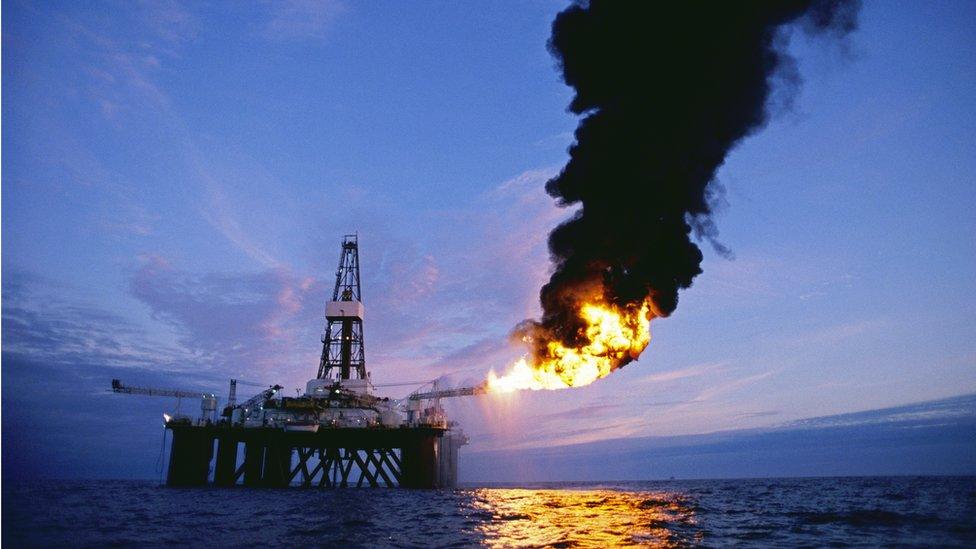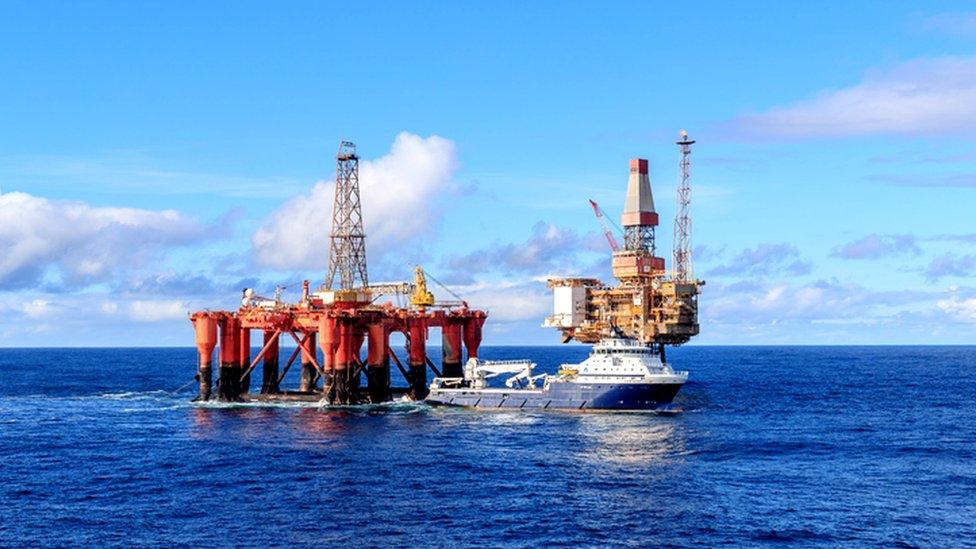Regulator warns North Sea production emissions could rise
- Published

An offshore oil exploration rig, in the Scottish sector of the North Sea, burns off oil and natural gas
Production emissions from oil and gas facilities in the North Sea fell last year but are expected to rise again, according to regulators.
Figures from the North Sea Transition Authority (NSTA) show total emissions were 14.6% lower than 2020 levels.
But it warned that without further investment the industry would miss its target to halve emissions by 2030.
The industry insisted it had made "good progress" and was another step closer to reaching its net zero goals.
Greenhouse gases from extracting oil and gas account for about 4% of the UK's total, which is about the same as a third of all Scotland's emissions.
But because energy is reserved, production from Scotland's waters is not counted in its annual audit.
The NSTA report attributed the latest fall in emissions to a combination of industry efforts, Covid disruption and an overall drop in production for delayed maintenance.
Almost three-quarters of those emissions come from generating power to run the installations, with gas flaring accounting for a further 22%.
The report said it would be a "challenge" to sustain the emissions reductions in future years as operations return to a more regular pattern.
But NSTA chief executive Dr Andy Samuel insisted the industry would be held to account to make sure it delivers on its targets.
He added: "The industry has made impressive progress on reducing emissions during a turbulent period marked by a global pandemic and unprecedented price volatility.
"Energy security is more sharply in focus than ever and the NSTA is working closely with industry and government to bring new oil and gas projects online and bolster UK energy supply. This vital work sits alongside emissions reduction goals."


Reducing production emissions is a key commitment as part of the industry's North Sea transition deal with the government.
Although there's been some initial progress, sustaining that will be difficult.
The figures have been helped by the decommissioning of some older, more polluting, platforms like Thistle Alpha in the northern North Sea.
It's further hoped that some assets can be powered by renewable electricity - rather than gas - within five years.
But the energy security crisis sparked by the war in Ukraine means the North Sea is now running at near full capacity.
And that means more emissions which will undoubtedly show up in these figures next year.

Total emissions for the UK oil and gas sector have fallen by 21.5% since the industry's benchmark year of 2018.
Despite the overall fall, the average emissions from produced oil has increased to the equivalent of 25.4kg of carbon dioxide per barrel.
This figure is called the "carbon intensity" of the sector.
The report says the UK is slightly higher than the median global average.

Ryan Morrison, from Friends of the Earth Scotland, said: "The irony should not be lost on anyone that as the fossil fuel industry thinks about attaching wind turbines to oil platforms, they are also pushing to drill every last drop of oil and gas.
"Worse still, this report shows that the pollution from each barrel is higher than the majority of other countries and has actually increased in the last year.
"Both climate science and energy experts are crystal clear that there can be no new oil or gas developments if we want to stay within the agreed limits of global temperature rises, no matter how much the industry tinkers around the edges of North Sea emissions."
Will Webster, from industry body OEUK, added: "Oil and gas will be needed for decades to come, so it's important that we meet as much of our own demand as possible in the most sustainable way we can.
"The NSTA's report shows industry has made good progress on the emissions reduction targets set out in the North Sea Transition Deal, marking another step closer to reaching our net zero goals."
- Published7 September 2022

- Published6 August 2021
